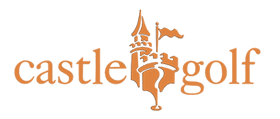MINIATURE GOLF COURSE DESIGN
Considerations of design on costs and profitability
THE SUCCESSFUL COURSE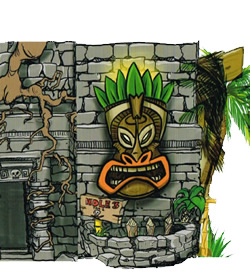
MINI GOLF COURSE DESIGN
The design of a course has a direct impact on your costs and profitability. The following considerations are just some of the important aspects when designing your course.
You should match the course to the market. In an area with high-volume potential, your course should be heavily themed to provide strong visual and emotional appeal. This inspires repeat play and high traffic that keeps you competitive with other nearby courses.
Unique golf course themes will translate into an excellent return on investment as well as provide a memorable brand identity.
Supporting the appearance package, thoughtfully designed and interesting holes are a foundation of your success. The PLAYABILITY factor requires that the ball roll true, that it goes where you putt it. It also means that the holes are designed to match the customers in your market. For some, this may mean a course that places a premium on skill and challenge. For most, this will be a family friendly course that balances skill and novelty, a course that results in players of all ages having a fun experience. These decisions should be addressed during the design phase of your course development.
Other details such as signage, landscaping and complementary facilities such as food service, plazas and party areas all figure in to what sort of experience your visitors will have. Increase repeat visits by providing an attractive, challenging (but playable!) and entertaining environment and an eventful final hole contribute to a happy memory of your course. Other details such as signage, landscaping and complementary facilities such as food service, plazas and party areas all figure in to what sort of experience your visitors will have. Increase repeat visits by providing an attractive, challenging (but playable!) and entertaining environment and an eventful final hole contribute to a happy memory of your course.
A Primer on Miniature Golf Design and Cost Variables
The big question that we are answering is: “What are the elements that make a difference in the cost of the miniature golf course?” These answers are based on the 40 years of experience and approach to design and construction used by Castle Golf, Inc. The big question that we are answering is: “What are the elements that make a difference in the cost of the miniature golf course?” These answers are based on the 40 years of experience and approach to design and construction used by Castle Golf, Inc.
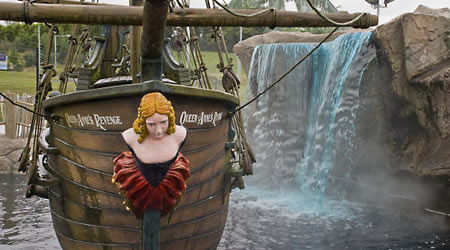
Water SystemsWaterfalls, Ponds, Pumps
The greater the surface area, the longer the rivers, the higher the costs. Greater length increases not only the concrete requirement, but also the labor time to set and remove the forms, and the materials. Mostly it is about the labor though costs of materials have clearly increased in the past year.
The larger the ponds and rivers, generally the greater the power and size of the pumps required. Pumps should be of commercial quality 5 to 15 hp pumps if you wish to move significant amounts of water as either waterfalls or fountains.
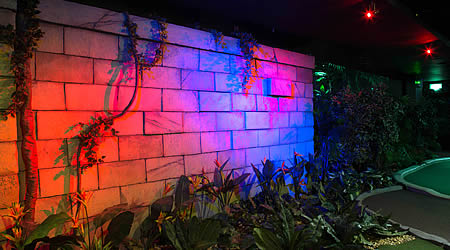
LightingFlood lights, Mood lighting
It is possible to reduce the cost of lighting the course by use of floodlights on poles. Our own preference whenever possible is to use high pressure sodium overhead lighting on 15 ft. poles and metal halide spot lights at key places such as fountains, scenes, waterfalls, and select plants. This combination of lighting has proven to be both a cost effective and a visually attractive approach to setting a mood on the course, yet providing adequate light for play. Themed lighting fixtures may also be appropriate in some settings.
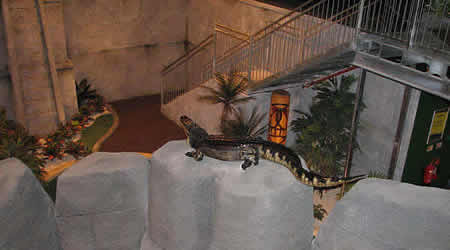
Elevation changePlaying levels
This can dramatically impact the cost in several ways. First and foremost, the addition of playing levels will typically require retaining walls. The higher the playing level, the higher and thicker must be the wall. There is a cost associated with this. Budgets need to be mindful of this factor as you consider the design of the course. Related to this are wheelchair access issues and the potential need for ramps.
The emerging standard (not official) appears to be that 50% of the course should be wheelchair accessible. The design for an 18-hole course could create a loop of 9 holes that are connected in such a way that they can be played twice.
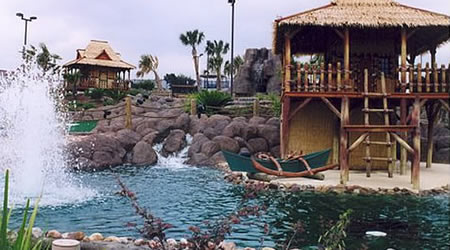
RockscapeRocks, Caves
The volume and quality of the artificial rock as well as the amount of natural rock will also impact the cost. Artificial rock is typically priced by the square foot and therefore as the rock surface area grows so does the cost.
Large cave structures also introduce elements of interior structural walls to provide safety and strength. There are alternatives to cave structures that may offer even more interesting features than caves as well as to be more cost effective.
From an appearance perspective, the challenge is to complete the rock features so that you do not get the “loaf of bread” appearance that is sometimes found as a centerpiece.
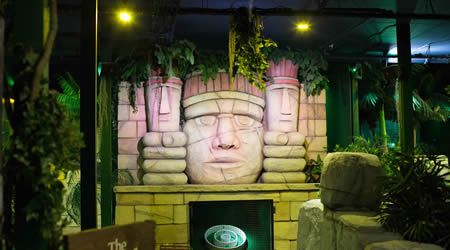
Theme Structures and ScenesThemes, Concepts
This aspect of the course typically has the widest range of costs associated with it…”the sky is the limit” cliche applies here. On the other hand, these can significantly improve your bottom line revenue and set your course apart.
Not only can the cost vary, as can the theme concepts. The key is to provide golf course themes that are timeless in their interest and that can be embellished over time. You must always ask, “What will the customers like?” in addition to your own preferences.
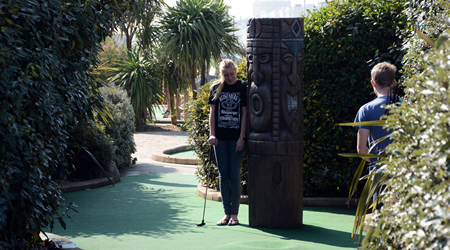
LandscapeSoft Landscaping, Planting
Plant material and ground cover can also vary depending upon you decisions as to maturity of the plants and the style of ground cover material. Your course designer/builder should work with you and your local landscape/nurseryman to address the issues.
Castle normally includes the sturdy ropes and poles, the bridge railings, and a surround water line as standard on the courses. There are less expensive materials available. These are important to both the safety issues and the visual appearance of the course.
How much land do I need to build a miniature golf Course
There are no absolute minimums and maximums for the area required. In general, an 18-hole outdoor miniature golf course commonly uses about one-half acre or 20,000 to 22,000 s.f. Your costs are effected because of the need to fill the vacant area with “something”, be it landscape, ground cover, concrete or water. In other words, use no more land surface than is required to accomplish your objective. Extra space may provide an opportunity for another revenue center….almost always a good thing.
Indoor Mini Golf Course Requirements
Indoor courses have increased in popularity, particularly in cold weather climates where they are typically matched in with other types of amusement elements or in large malls with strong foot traffic, typically near or inclusive of other entertainment venues such as lazer tag, food courts, arcades, etc. The size of these indoor courses typically ranges from 6,000 square feet to 12,000 square feet. Castle Golf encourages course sizes to be closer to 9,000 s.f. than 6,000 s.f. whenever possible.
Castle Golf also believes that an indoor miniature golf should be viewed in a different light than its outdoor counterpart. Because the holes are smaller, the game changes. But because the courses are not subject to weather conditions; opportunities for exciting themes and special effects make it possible to provide increased entertainment values to be built into the course environment. This will be evident in our indoor photo gallery.
Testimonials
Client testimonials. Our customers speak for us...
view
Project Gallery
Browse through our project gallery. A show case of past and present miniature golf courses we have built.
view
Mini Golf Success
The successful miniature golf course delivers entertainment, fun, challenge and satisfaction.
read more

